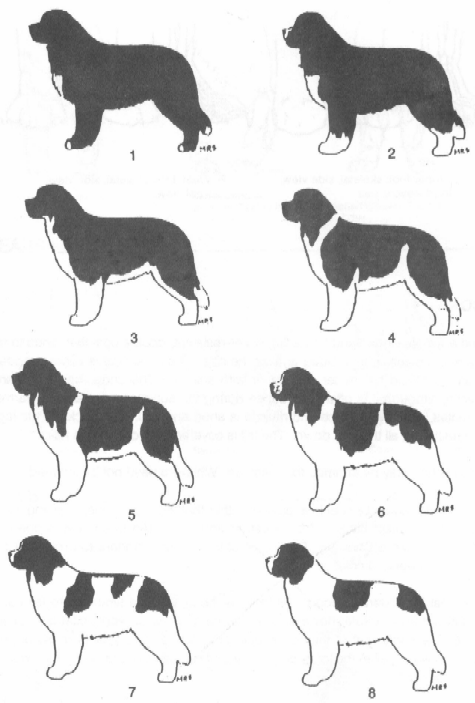
COLOR
Color is secondary to type, structure and soundness.
Recognized Newfoundland colors are black, brown, gray, and white and black.
Solid Colors: Blacks, Browns, and Grays may appear as solid colors or solid colors with white at any, some, or all, of the following locations: chin, chest, toes, and tip of tail. Any amount of white found at these locations is typical and is not penalized. Also typical are a tinge of bronze on a black or gray coat and lighter furnishings on a brown or gray coat.
Landseer- white base coat with black markings. Typically, the head is solid black, or black with white on the muzzle, with or without a blaze. There is a separate black saddle and black on the rump extending onto a white tail.
Markings, on either solid colors or Landseers, might deviate considerably from those described and should be penalized only to the extent of the deviation. Clear white or white with minimal ticking is preferred.
Beauty of markings should be considered only when comparing dogs of otherwise comparable quality and never at the expense of type, structure and soundness.
All acceptable colors have equal status. The bronze tinge or lighter furnishings on a solid color dog are caused by weathering or bleaching from the sun and should not be faulted. Brown may be any shade from dark chocolate to russet.
A rule of thumb for acceptable markings is:
Solid Black
Black with white or white with black
Solid brown or gray. If white is present, it may not be so extensive that either brown or gray cannot be identified as the base color.
White dogs with black markings are described in the Standard as "Landseers" in honor of Sir Edwin Landseer, the 19th Century artist who featured white and black Newfoundlands in numerous paintings.
Pictured are examples of some frequently encountered color patterns, all acceptable on black/white or white/black dogs. Any Newfoundland whose coat color is brown and white or gray and white is to be disqualified if white is, without question, the predominant color, a decision to be determined by the judge.
It is necessary to know the ideal patterns for solid colored and white with black Newfoundlands when comparing dogs of otherwise equal quality. On a solid colored dog, white which extends onto the feet or up the leg or on the face should be considered a minor deviation. White and black Newfoundlands have a piebald color pattern limited to white as the base color, and black area markings. These markings should be separated by clearly defined white areas of background color. While some minor ticking may or may not be present, excess ticking detracts from the contrast of the white and black coat.
Markings may deviate considerably from those described, including asymmetrical markings on either solid colored or white with black dogs. Markings may extend well beyond the areas described. Since predictability of markings is genetically unreliable, beauty of marking should be considered only when comparing marked dogs of equal quality.
DISQUALIFICATIONS
Any colors or combinations of colors not specifically described are disqualified.
Note that there is no mention of markings. With respect to disqualification, markings are considered only when they are the wrong color.
White is not listed as an acceptable solid color, so white dogs with no black markings would be disqualified. A black and white or a white and black dog may have markings so deviant from the described patterns that it is difficult to tell whether it is a black or a white and black. Such a dog may be shown in either the black or AOAC class and would not be disqualified, since either black with white or white with black is an acceptable combination. However, with other marked solid colors, either brown or gray must be identifiable as the base color to avoid disqualification, since the Standard describes white dogs as having black markings only.
Examples of other disqualifying colors include, but are not limited to: any non-solid base color (or markings) such as merle, roan, or brindle, and black, brown, or gray base coat with markings other than white. Beige, tan, honey, buff, blond, or any pale shade of brown must be disqualified.
| BACK | CONTENTS | NEXT |